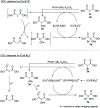Cross dehydrogenative C-O coupling catalysed by a catenane-coordinated copper(i)
- PMID: 34094485
- PMCID: PMC8163234
- DOI: 10.1039/d0sc05133k
Cross dehydrogenative C-O coupling catalysed by a catenane-coordinated copper(i)
Abstract
Catalytic activity of copper(i) complexes supported by phenanthroline-containing catenane ligands towards a new C(sp3)-O dehydrogenative cross-coupling of phenols and bromodicarbonyls is reported. As the phenanthrolines are interlocked by the strong and flexible mechanical bond in the catenane, the active catalyst with an open copper coordination site can be revealed only transiently and the stable, coordinatively saturated Cu(i) pre-catalyst is quickly regenerated after substrate transformation. Compared with a control Cu(i) complex supported by non-interlocked phenanthrolines, the catenane-supported Cu(i) is highly efficient with a broad substrate scope, and can be applied in gram-scale transformations without a significant loss of the catalytic activity. This work demonstrates the advantages of the catenane ligands that provide a dynamic and responsive copper coordination sphere, highlighting the potential of the mechanical bond as a design element in transition metal catalyst development.
This journal is © The Royal Society of Chemistry.
Conflict of interest statement
There are no conflicts to declare.
Figures




Similar articles
-
A Copper(I) Catenane Decorated Metal-Organic Layer as a Heterogenous Catalyst for Dehydrogenative Cross-Coupling.Chemistry. 2025 Jun 3;31(31):e202500866. doi: 10.1002/chem.202500866. Epub 2025 Apr 26. Chemistry. 2025. PMID: 40241498 Free PMC article.
-
Water and Air Stable Copper(I) Complexes of Tetracationic Catenane Ligands for Oxidative C-C Cross-Coupling.Angew Chem Int Ed Engl. 2024 Jul 8;63(28):e202405971. doi: 10.1002/anie.202405971. Epub 2024 Jun 3. Angew Chem Int Ed Engl. 2024. PMID: 38661248
-
Mechanical Interlocking Enhances the Electrocatalytic Oxygen Reduction Activity and Selectivity of Molecular Copper Complexes.J Am Chem Soc. 2023 Mar 22;145(11):6087-6099. doi: 10.1021/jacs.2c10988. Epub 2023 Feb 28. J Am Chem Soc. 2023. PMID: 36853653
-
Inhibition and oxygen activation in copper amine oxidases.Acc Chem Res. 2015 May 19;48(5):1218-26. doi: 10.1021/ar500460z. Epub 2015 Apr 21. Acc Chem Res. 2015. PMID: 25897668 Review.
-
A Decade of Electrochemical Dehydrogenative C,C-Coupling of Aryls.Acc Chem Res. 2020 Jan 21;53(1):45-61. doi: 10.1021/acs.accounts.9b00511. Epub 2019 Dec 18. Acc Chem Res. 2020. PMID: 31850730 Review.
Cited by
-
A Copper(I) Catenane Decorated Metal-Organic Layer as a Heterogenous Catalyst for Dehydrogenative Cross-Coupling.Chemistry. 2025 Jun 3;31(31):e202500866. doi: 10.1002/chem.202500866. Epub 2025 Apr 26. Chemistry. 2025. PMID: 40241498 Free PMC article.
-
Distinctive features and challenges in catenane chemistry.Chem Sci. 2022 Feb 7;13(12):3315-3334. doi: 10.1039/d1sc05391d. eCollection 2022 Mar 24. Chem Sci. 2022. PMID: 35432874 Free PMC article. Review.
-
Broadband and strong visible-light-absorbing cuprous sensitizers for boosting photosynthesis.Proc Natl Acad Sci U S A. 2022 Dec 13;119(50):e2213479119. doi: 10.1073/pnas.2213479119. Epub 2022 Dec 5. Proc Natl Acad Sci U S A. 2022. PMID: 36469783 Free PMC article.
-
Controlling catalyst activity, chemoselectivity and stereoselectivity with the mechanical bond.Nat Rev Chem. 2022 Mar;6(3):182-196. doi: 10.1038/s41570-021-00348-4. Epub 2022 Jan 21. Nat Rev Chem. 2022. PMID: 37117433 Review.
-
A Robust Pyrazolate Metal-Organic Framework for Efficient Catalysis of Dehydrogenative C-O Cross Coupling Reaction.J Am Chem Soc. 2024 May 22;146(20):14174-14181. doi: 10.1021/jacs.4c03038. Epub 2024 May 9. J Am Chem Soc. 2024. PMID: 38723205 Free PMC article.
References
-
-
For selected reviews, see:
- Evano G. and Blanchard N.Copper Mediated Cross-Coupling Reactions, John Wiley & Sons Inc., New Jersey, 2013
- Beletskaya I. P. Cheprakov A. V. Coord. Chem. Rev. 2004;248:2337. doi: 10.1016/j.ccr.2004.09.014. - DOI
- Evano G. Blanchard N. Toumi M. Chem. Rev. 2008;108:3054. doi: 10.1021/cr8002505. - DOI - PubMed
- Prokopcova H. Kappe C. O. Angew. Chem., Int. Ed. 2008;47:3674. doi: 10.1002/anie.200800449. - DOI - PubMed
- Surry D. S. Buchwald S. L. Chem. Sci. 2010;1:13. doi: 10.1039/C0SC00107D. - DOI - PMC - PubMed
- Evano G. Theunissen C. Pradal A. Nat. Prod. Rep. 2013;30:1467. doi: 10.1039/C3NP70071B. - DOI - PubMed
- Casitas A. Ribas X. Chem. Sci. 2013;4:2301. doi: 10.1039/C3SC21818J. - DOI
- Bhunia S. Pawar G. G. Kumar S. V. Jiang Y. Ma D. Angew. Chem., Int. Ed. 2017;56:16136. doi: 10.1002/anie.201701690. - DOI - PubMed
- Hossain A. Bhattacharyya A. Reiser O. Science. 2019;364:eaav9713. doi: 10.1126/science.aav9713. - DOI - PubMed
-
-
-
For examples of phenanthroline-supported, coordinatively saturated copper-based coupling catalysts:
- Hossain A. Engl S. Lutsker E. Reiser O. ACS Catal. 2019;9:1103. doi: 10.1021/acscatal.8b04188. - DOI
- Rawner T. Lutsker E. Kaiser C. A. Reiser O. ACS Catal. 2018;8:3950. doi: 10.1021/acscatal.8b00847. - DOI
-
-
- Jones G. R. Anastasaki A. Whitfield R. Engelis N. Liarou E. Haddleton D. M. Angew. Chem., Int. Ed. 2018;57:10468. doi: 10.1002/anie.201802091. - DOI - PubMed
- Wendlandt A. E. Suess A. M. Stahl S. S. Angew. Chem., Int. Ed. 2011;50:11062. doi: 10.1002/anie.201103945. - DOI - PubMed
- Trammell R. Rajabimoghadam K. Garcia-Bosch I. Chem. Rev. 2019;119:2954. doi: 10.1021/acs.chemrev.8b00368. - DOI - PMC - PubMed
- Iwamatsu S. Matsubara K. Nagashima H. J. Org. Chem. 1999;64:9625. doi: 10.1021/jo9912146. - DOI
LinkOut - more resources
Full Text Sources
Other Literature Sources
Research Materials

